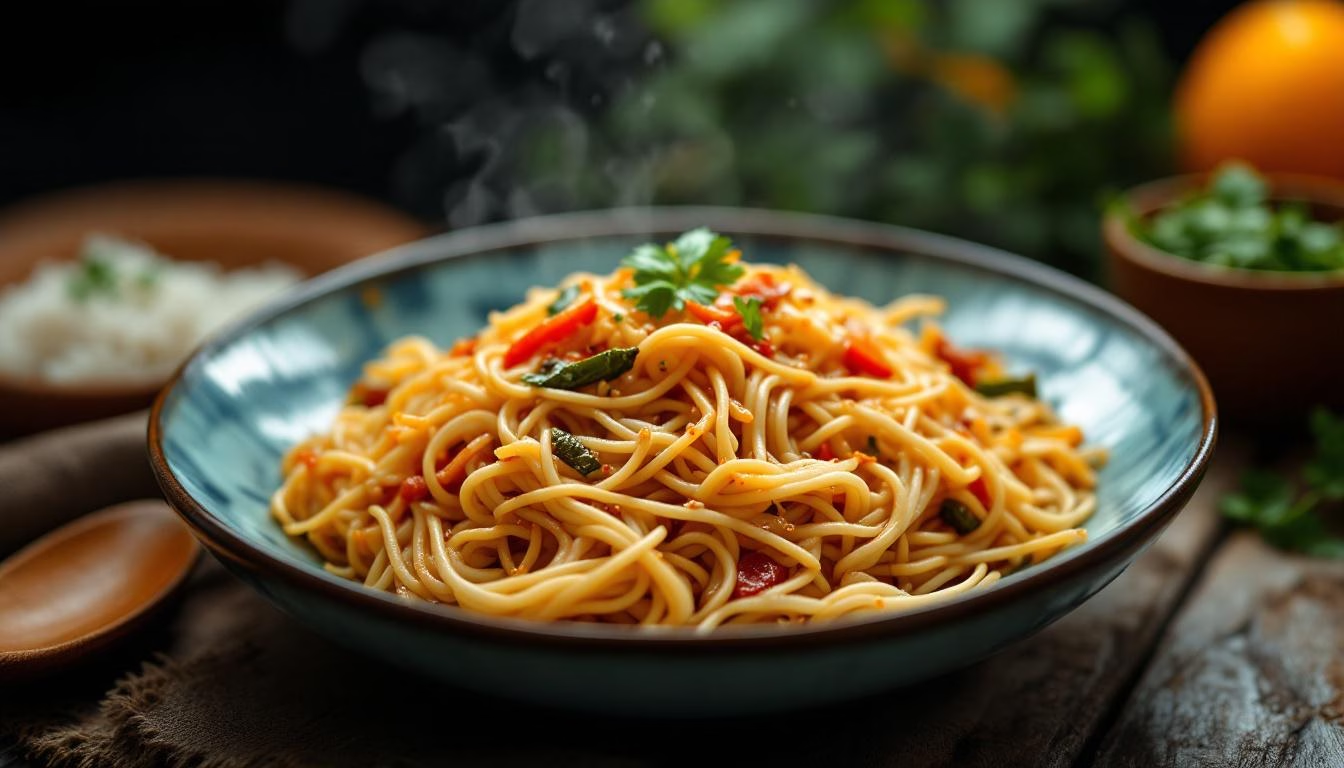Easy Bihun Goreng Recipe – Indonesian Rice Vermicelli
The Best Bihun Goreng (Indonesian Stir Fried Rice Vermicelli) Recipe – Last Tuesday, I was standing in my kitchen at 6 PM, staring into my refrigerator with that familiar “what on earth am I going to make for dinner” panic.

Bihun Goreng (Indonesian Stir Fried Rice Vermicelli)
Ingredients
- 3.5 ounces rice vermicelli (a 100 g. bundle)
- 3 tablespoons vegetable oil (or canola oil, or sunflower oil)
- 7 oz. Extra firm tofu ((200 g. / half a block) small dice)
- 2 scallions (cut into 1-inch (2.5 cm.) sections)
- 1 medium shallot (diced)
- 2 cloves garlic (minced)
- 2 cups bean sprouts
- 4 baby bok choy (or bok choy shoots, leaves separated)
- 1 ½ cups Napa cabbage (roughly chopped)
- ⅓ cup water
- 2 tablespoons sriracha (or sambal oelek)
- 3 tablespoons vegetarian oyster sauce
- 2 tablespoons kecap manis (sweet soy sauce)
- ½ teaspoon white pepper
- 1 ½ teaspoons cornstarch
- Thinly sliced scallions
- Sliced bird’s eye chilies
Instructions
- Soak the thin rice vermicelli in warm water, letting them sit while you continue with the next steps.
- Heat cooking oil in a wok or Dutch oven over medium-high heat. After 90 seconds, when the oil is hot, add the diced extra firm tofu and fry for about six minutes until golden and crispy on all sides.
- Add the diced shallot, scallion sections, and minced garlic. Stir-fry with the tofu for a couple of minutes until fragrant and slightly softened.
- Stir in the bean sprouts, baby bok choy, and roughly chopped Napa cabbage. Stir-fry for around 2–3 minutes until the vegetables start to wilt but still retain some crunch.
- Drain the soaked rice vermicelli, then add them to the pan with the vegetables and tofu.
- In a bowl, whisk together water, sambal oelek, vegetarian oyster sauce, kecap manis, white pepper, and cornstarch until smooth. Pour this sauce over the stir-fry and stir well to coat evenly, continuing to stir until the sauce thickens and coats everything nicely.
- Transfer the stir-fried rice noodles to serving plates, then garnish with thinly sliced scallions and sliced bird’s eye chilies.
Nutrition
You know the feeling – when you’ve got a handful of vegetables that are teetering on the edge of wilted, some leftover tofu that’s been giving you the side-eye for three days, and absolutely zero inspiration.
My husband was due home in an hour, and I had promised him something “real” for dinner, not another bowl of cereal or my infamous “whatever’s in the pantry” pasta.
That’s when I spotted the package of rice vermicelli tucked behind a jar of pickles in the back of my pantry.
I’d bought it months ago with grand plans to make Vietnamese spring rolls, but you know how these things go – life happened, the spring rolls never materialized, and there it sat, patiently waiting for its moment to shine.
As I pulled out that crinkly package, memories of a tiny Indonesian restaurant in my old neighborhood came flooding back.
They made this incredible Bihun Goreng that was somehow both comforting and exciting, simple yet complex, and I’d been meaning to recreate it for years.
Armed with nothing but determination and whatever vegetables I could rescue from my crisper drawer, I decided this was the night.
What followed was one of those magical cooking moments where everything just clicks – the tofu got perfectly golden, the vegetables retained just the right amount of crunch, and the sauce came together like it had been waiting its whole life for this exact combination of ingredients.
My husband took one bite and declared it “restaurant-quality,” which in our house is the highest possible praise.
Restaurant-Style Bihun Goreng Recipe with Crispy Tofu
Bihun Goreng, literally translated as “fried rice vermicelli,” is one of those wonderfully adaptable Indonesian dishes that proves you don’t need a million ingredients to create something absolutely delicious.
Unlike its more famous cousin, mie goreng (fried noodles), this Bihun Goreng recipe uses delicate rice vermicelli that soaks up flavors like tiny, edible sponges.
What I love most about this dish is its beautiful balance – the rice noodles provide a light, almost ethereal base, while crispy tofu adds protein and texture.
Fresh vegetables like bean sprouts, bok choy, and Napa cabbage bring crunch and color, all tied together with a sauce that’s sweet, savory, and just spicy enough to wake up your taste buds.
The key players here are kecap manis (Indonesian sweet soy sauce) and sambal oelek, which create that distinctive Indonesian flavor profile that’s both familiar and exotic.
This isn’t just another stir-fry – it’s a complete meal that happens to come together in about 22 minutes from start to finish.
The technique is straightforward enough for a weeknight dinner, but the results are impressive enough for company.
Plus, it’s naturally vegetarian (though you can easily add shrimp, chicken, or whatever protein makes you happy).
Essential Ingredients for Perfect Bihun Goreng
Before we dive into the cooking process, let’s talk about what makes this Bihun Goreng recipe truly sing.
The beauty of this dish lies in its simplicity, but that means each ingredient needs to pull its weight.
The Noodle Foundation
Rice vermicelli (bihun) is the star of this show, and not all rice noodles are created equal.
Look for the thin, white rice vermicelli that comes in neat little bundles – they’re usually found in the Asian section of your grocery store.
These noodles are different from the thicker rice noodles used in pad thai; they’re delicate, almost hair-like strands that cook quickly and have an amazing ability to absorb flavors.
The soaking technique is crucial here.
Unlike pasta, you don’t boil these noodles – you simply soak them in warm water until they’re pliable.
This usually takes about 10-15 minutes, which is perfect timing since that’s exactly how long it takes to prep your other ingredients.
Building Flavor with Aromatics
The holy trinity of Indonesian cooking – shallots, garlic, and scallions – forms the aromatic base of our Bihun Goreng recipe.
I’ve learned that dicing the shallot finely is key; you want those sweet, oniony flavors distributed throughout the dish, not hiding in big chunks.
The garlic should be minced well, and the scallions cut into inch-long pieces so they maintain some texture.
The Sauce That Makes Everything Magical
Here’s where the magic happens: kecap manis (sweet soy sauce) is absolutely non-negotiable for authentic flavor.
It’s thicker and sweeter than regular soy sauce, with a molasses-like consistency that coats the noodles beautifully.
If you can’t find it, you can make a substitute by mixing regular soy sauce with brown sugar, but trust me, it’s worth seeking out the real thing.
Sambal oelek brings the heat – it’s a simple chili paste that adds warmth without overwhelming the dish.
Vegetarian oyster sauce provides umami depth, while white pepper adds a subtle bite that’s different from black pepper.
The cornstarch might seem like a small detail, but it’s what transforms our sauce from watery to glossy and clingy.
Step-by-Step Cooking Instructions
Now that we’ve covered the why, let’s get to the how.
This Bihun Goreng recipe moves quickly once you start cooking, so having everything prepped and ready is essential – what the professionals call “mise en place,” and what I call “not wanting to burn dinner while frantically chopping vegetables.”
Preparing Your Workspace
First things first: get that rice vermicelli soaking in warm water.
This isn’t a step you want to rush, so start here and let time do the work while you handle everything else.
The noodles are ready when they’re completely pliable but still have a slight bite – think al dente pasta, but more delicate.
While the noodles soak, prep all your vegetables and mix your sauce.
I cannot stress this enough: once you start cooking, there’s no time to stop and chop more garlic or hunt for the kecap manis.
Have everything measured, chopped, and within arm’s reach of your stove.
Getting the Tofu Golden and Crispy
Heat your oil in a wok or large skillet over medium-high heat – and yes, you really do need that much oil for proper tofu crisping.
The key to perfect tofu is patience and the right temperature.
When you add the cubed tofu, it should sizzle immediately but not violently.
If it’s too quiet, your oil isn’t hot enough; if it’s spitting and angry, turn the heat down a notch.
Let the tofu do its thing for about 6 minutes, resisting the urge to move it around too much.
You want golden, crispy edges on all sides, which only happens when you give each surface time to properly brown.
This is where many home cooks go wrong – they get impatient and start stirring too early, resulting in sad, pale tofu that never achieves its crispy potential.
Building Layers of Flavor
Once your tofu is gorgeously golden, add the aromatics directly to the same pan.
The combination of hot oil and tofu creates the perfect environment for blooming those shallot, garlic, and scallion flavors.
You’ll know you’re on the right track when your kitchen starts smelling like the best Indonesian restaurant you’ve ever been to.
Stir-fry these aromatics with the tofu for about 2 minutes – just long enough for the shallots to soften and the garlic to become fragrant.
Don’t let the garlic brown too much; bitter garlic will ruin the entire dish.
Adding Vegetables for Perfect Texture
Next come the vegetables, and timing is everything here.
Bean sprouts, bok choy, and Napa cabbage all cook at different rates, but they all need to retain some crunch.
Add them all at once and stir-fry for 2-3 minutes – you want them wilted but not limp, tender but not mushy.
The vegetables should still have some bite when you add the noodles.
Remember, they’ll continue cooking as you add the sauce and finish the dish, so slightly underdone at this stage is perfect.
Bringing It All Together
Drain your soaked noodles and add them to the pan.
Here’s where things get fun – the noodles will seem like a lot at first, but they’ll shrink and integrate as you stir.
Be gentle but thorough; you want every strand coated with that aromatic oil and mixed with the vegetables and tofu.
Now for the sauce: whisk all the sauce ingredients together in a bowl until smooth, then pour it over the entire stir-fry.
The cornstarch will thicken the sauce as it heats, creating a glossy coating that clings to every noodle.
Keep stirring until everything is evenly coated and the sauce has thickened slightly – this usually takes about 2 minutes.
Pro Tips for Bihun Goreng Success
After making this Bihun Goreng recipe more times than I can count (and making every possible mistake along the way), I’ve learned a few tricks that make the difference between good and absolutely spectacular.
Temperature Control is Everything
Maintain medium-high heat throughout the cooking process, but don’t be afraid to adjust if things are browning too quickly or too slowly.
Your stove is different from mine, your pan conducts heat differently, and even the humidity in your kitchen can affect cooking times.
Trust your senses more than the timer.
If your aromatics start browning too quickly, lower the heat.
If your vegetables seem to be taking forever to wilt, bump it up a bit.
The goal is steady, consistent cooking that builds flavor without burning anything.
The Art of Sauce Consistency
The sauce should coat the noodles without being gloppy or leaving a puddle at the bottom of the pan.
If it seems too thick, add a tablespoon of water.
If it’s too thin, let it cook a bit longer – the cornstarch will continue to thicken as it heats.
I’ve found that whisking the sauce ingredients really well before adding them prevents any cornstarch lumps, which can create an unpleasant texture.
Take the extra 30 seconds to whisk until completely smooth.
Noodle Soaking Secrets
Don’t over-soak your rice vermicelli – they’ll continue to soften in the hot pan, and mushy noodles are the enemy of good Bihun Goreng.
They should be pliable but still have some structure when you drain them.
If you accidentally over-soak them (we’ve all been there), drain them immediately and rinse with cold water to stop the softening process.
They’ll still work, just be extra gentle when stirring.
Garnish Like You Mean It
Those final garnishes aren’t just for looks – thinly sliced scallions add a fresh, sharp contrast to the rich, savory noodles, while sliced bird’s eye chilies provide optional heat for those who want it.
Don’t skip these finishing touches; they really do make a difference in the final dish.
Creative Variations and Substitutions
One of the things I love most about this Bihun Goreng recipe is how adaptable it is to whatever you have on hand or whatever your dietary needs require.
Protein Variations
While the tofu version is absolutely delicious, this dish welcomes other proteins with open arms.
Shrimp works beautifully – add it after the aromatics and cook just until pink.
Chicken thighs, cut into bite-sized pieces, can replace the tofu entirely; just cook them through before adding the vegetables.
For a completely plant-based version, try adding strips of shiitake mushrooms or even some crumbled tempeh.
The key is to get whatever protein you’re using nicely browned for maximum flavor.
Vegetable Flexibility
The vegetables in this recipe are more like suggestions than requirements.
Broccoli florets, snap peas, carrots, or bell peppers all work wonderfully.
The trick is to add harder vegetables (like carrots) earlier in the cooking process and softer ones (like spinach) toward the end.
If you can’t find baby bok choy, regular bok choy works fine – just chop it into smaller pieces.
No Napa cabbage?
Regular cabbage, thinly sliced, is a perfectly acceptable substitute.
Sauce Adjustments
Can’t find kecap manis?
Mix 3 tablespoons regular soy sauce with 1 tablespoon brown sugar and a teaspoon of molasses if you have it.
It won’t be exactly the same, but it’ll get you in the right flavor neighborhood.
For a spicier version, increase the sambal oelek or add some fresh sliced chilies with the aromatics.
For a milder version, reduce or omit the sambal oelek entirely – the dish will still be delicious.
Dietary Modifications
This Bihun Goreng recipe is naturally vegetarian and can easily be made vegan by ensuring your oyster sauce is plant-based (many brands now make excellent vegetarian versions).
For gluten-free diners, check that your soy sauces are gluten-free – many are, but it’s worth double-checking.
If you’re watching sodium, you can reduce the amount of soy sauce and oyster sauce, though you might want to add a bit more white pepper or some fresh ginger to maintain the flavor complexity.
What to Expect and Final Thoughts
Here’s the honest truth about this Bihun Goreng recipe: your first attempt might not look exactly like the photo, and that’s completely okay.
Mine certainly didn’t.
The noodles might clump a bit more than you’d like, or maybe you’ll add the sauce too quickly and it won’t distribute evenly.
These are all normal parts of the learning process, and even imperfect Bihun Goreng is still pretty delicious.
What you can expect is a dish that’s satisfying without being heavy, flavorful without being overwhelming, and surprisingly filling despite its light appearance.
The rice vermicelli has this wonderful way of absorbing all those aromatic flavors while maintaining its delicate texture.
The vegetables provide pops of color and crunch, while the tofu adds protein and substance.
This isn’t a dish that improves with sitting – it’s best enjoyed immediately, while the noodles still have that perfect texture and the vegetables retain their crunch.
That said, leftovers (if you have any) can be quickly reheated in a skillet with a splash of water to loosen things up.
The beauty of this Bihun Goreng recipe lies not just in its flavors, but in its simplicity and speed.
It’s become my go-to solution for those nights when I want something that feels special but doesn’t require hours of preparation.
It’s proof that with the right techniques and quality ingredients, you can create something truly satisfying in less than 25 minutes.
So go ahead, give it a try.
Embrace the inevitable small imperfections, adjust the seasonings to your taste, and make it your own.
That’s what cooking is all about, after all – taking a recipe and making it work for your kitchen, your family, and your life.
Bihun Goreng (Indonesian Stir Fried Rice Vermicelli) Recipe
- Prep Time: 10 minutes
- Cook Time: 12 minutes
- Total Time: 22 minutes
- Servings: 5
Ingredients
- 3.5 ounces rice vermicelli (a 100 g bundle)
- 3 tablespoons vegetable oil (or canola oil, or sunflower oil)
- 7 oz. extra firm tofu (200 g / half a block, small dice)
- 2 scallions (cut into 1-inch sections)
- 1 medium shallot (diced)
- 2 cloves garlic (minced)
- 2 cups bean sprouts
- 4 baby bok choy (or bok choy shoots, leaves separated)
- 1½ cups Napa cabbage (roughly chopped)
- ⅓ cup water
- 2 tablespoons sriracha (or sambal oelek)
- 3 tablespoons vegetarian oyster sauce
- 2 tablespoons kecap manis (sweet soy sauce)
- ½ teaspoon white pepper
- 1½ teaspoons cornstarch
For garnish:
- Thinly sliced scallions
- Sliced bird’s eye chilies
Instructions
- Soak rice vermicelli: Soak the thin rice vermicelli in warm water, letting them sit while you continue with the next steps.
- Fry tofu until golden: Heat cooking oil in a wok or Dutch oven over medium-high heat.After 90 seconds, when the oil is hot, add the diced extra firm tofu and fry for about six minutes until golden and crispy on all sides.
- Stir-fry shallot, scallions, and garlic: Add the diced shallot, scallion sections, and minced garlic.Stir-fry with the tofu for a couple of minutes until fragrant and slightly softened.
- Stir-fry sprouts and greens: Stir in the bean sprouts, baby bok choy, and roughly chopped Napa cabbage.Stir-fry for around 2–3 minutes until the vegetables start to wilt but still retain some crunch.
- Add noodles to the pan: Drain the soaked rice vermicelli, then add them to the pan with the vegetables and tofu.
- Whisk sauce and coat stir-fry: In a bowl, whisk together water, sambal oelek, vegetarian oyster sauce, kecap manis, white pepper, and cornstarch until smooth.Pour this sauce over the stir-fry and stir well to coat evenly, continuing to stir until the sauce thickens and coats everything nicely.
- Plate and garnish: Transfer the stir-fried rice noodles to serving plates, then garnish with thinly sliced scallions and sliced bird’s eye chilies.
Nutrition per serving: 233 calories, 31g carbs, 6g protein, 9g fat







